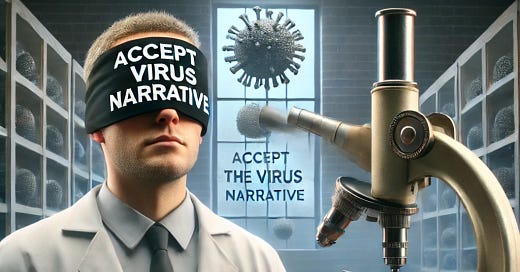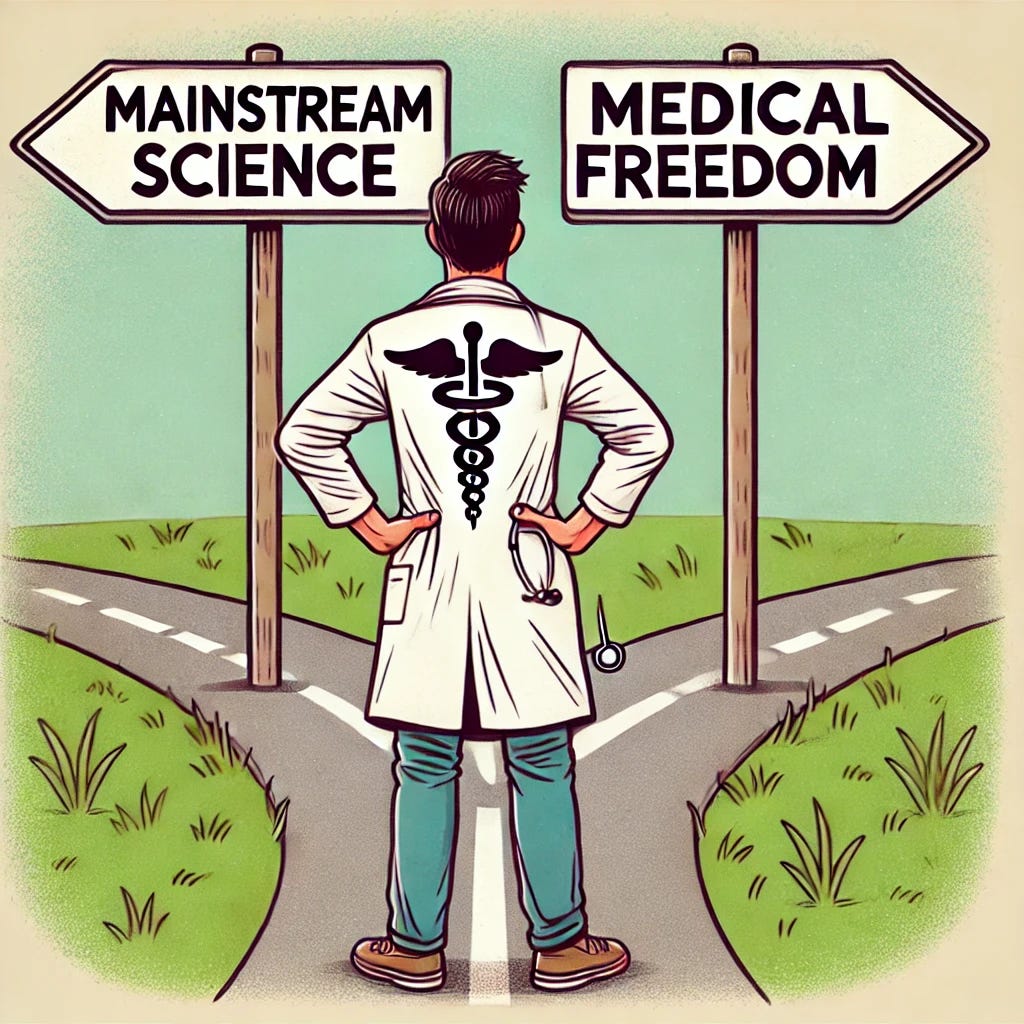Analysis and Counterarguments to A Midwestern Doctor's Blog Post on Virus Debunkers
Examining A Midwestern Doctor’s Case Against Virus Skepticism
A Midwestern Doctor recently published a blog post attempting to debunk the "no virus" position, arguing that those who question the existence of SARS-CoV-2 are harming the medical freedom movement, acting in bad faith, and misunderstanding basic virology. He claims that rejecting the virus paradigm makes it harder to fight mandates, alienates moderates, and distracts from more pressing issues. While he presents his argument as a reasoned critique, his approach relies more on political strategy than scientific refutation.
Below is my analysis of his key points, where I highlight his logical inconsistencies, selective framing, and avoidance of the fundamental flaws in virology. Read his article here:
Analysis and Counterarguments to A Midwestern Doctor's Blog Post on Virus Debunkers
I. Framing the "No Virus" Position as a Problem for the Medical Freedom Movement
A Midwestern Doctor (AMD) presents his case against the "no virus" position primarily from a strategic and political standpoint rather than a scientific one. He asserts that questioning the existence of viruses:
Divides the movement – He suggests internal debate weakens opposition to mandates.
Damages credibility – He claims that most people find virus denialism “insane.”
Pushes away moderates – He argues that accepting the virus paradigm is necessary to win legal and political battles.
Harms the unvaccinated – He states that people who dismiss COVID-19 entirely delay treatment and end up in hospitals.
Dilutes terrain theory’s legitimacy – He claims "extremist" virus denialism makes it harder for moderate terrain theory ideas to be taken seriously.
Counterarguments:
Truth matters more than strategy: If the virus paradigm is fundamentally flawed, ignoring it to "maintain unity" means conceding a false foundation to the enemy, giving them the justification to keep imposing mandates.
Credibility should not depend on mainstream approval: The same logic was used against early vaccine skeptics—dismissed as “conspiracy theorists” despite later evidence proving them right.
The existence of a virus should be judged on scientific merit, not political expediency: Just because something is unpopular doesn’t mean it’s incorrect.
The “delaying treatment” argument is a strawman: The existence of SARS-CoV-2 is independent of whether COVID-19 symptoms can be treated with early intervention. People rejecting the virus paradigm do not necessarily reject illness itself.
II. Claiming That Virus Debunkers Argue in Bad Faith
AMD paints the virus debunking movement as inherently dishonest and driven by ulterior motives, suggesting that:
Some virus skeptics are deliberately infiltrating the movement to discredit it.
Some former doctors lost their licenses and now need to profit from their theories.
Many virus debunkers refuse to debate openly and instead use inflammatory rhetoric.
Counterarguments:
Lumping all virus skeptics together is intellectually lazy: There are serious, well-credentialed scientists like Drs. Sam and Mark Bailey who have extensively deconstructed virology in good faith. Their critiques deserve engagement on scientific grounds, not ad hominem attacks.
Economic incentives exist on both sides: If a former doctor profits from consulting while advocating terrain theory, how is that worse than virologists receiving millions in grants to perpetuate their own research? Does Dr. Anthony Fauci have no financial interests?
The mainstream also avoids real debate: The very same accusation—dodging open debates—is true of virologists and pandemic policymakers. Have any major health agencies debated virus skeptics directly?
III. Claiming That the Scientific Method Supports Viruses
AMD claims that:
The scientific method requires a falsifiable hypothesis.
Virus skeptics create unfalsifiable arguments (e.g., demanding "pure virus isolation" when viruses must be cultured in cells).
Rejecting inference-based conclusions means rejecting all science, which relies on indirect evidence.
Counterarguments:
The burden of proof is on those making the claim: The existence of SARS-CoV-2 is an affirmative claim, and it is the responsibility of its proponents to prove its existence. The virus skeptics are merely questioning whether this has actually been done according to rigorous scientific principles.
Virology’s methods are deeply flawed:
Virologists never isolate a virus in the true sense (i.e., separating it from all other contaminants). Instead, they mix a patient sample with kidney cells, starve the cells of nutrients, add toxic antibiotics, and then observe cell death (CPE) without proving the virus was the cause.
Genome sequencing is an artificial construct: The SARS-CoV-2 genome was assembled in a computer from tiny RNA fragments, with no proof that all those fragments came from a single, intact virus.
PCR tests cannot confirm viral infection, only the presence of certain RNA sequences, which could come from exosomes, cellular debris, or other sources.
Science is not settled by inference alone: The fact that some scientific conclusions rely on indirect evidence does not mean all indirect evidence is equally valid. The question is whether the methods used to infer viral existence are scientifically sound—which virus skeptics argue they are not.
IV. Attempting to Dismiss Virus Skeptics on the Basis of the Dunning-Kruger Effect
AMD claims that:
Virus skeptics lack the necessary expertise to question virology.
They misinterpret scientific methods and exaggerate minor inconsistencies in virus research.
Counterarguments:
Many virus skeptics are scientifically trained: Drs. Sam and Mark Bailey, Dr. Andrew Kaufman, and Dr. Stefan Lanka are highly educated professionals who have methodically deconstructed virology. Calling them “ignorant” is dismissive and lazy.
Dunning-Kruger applies to mainstream scientists too: If virus skeptics misunderstand virology, what about virologists who misunderstand terrain theory or deliberately ignore flaws in their own field?
Questioning foundational assumptions is the essence of science: If expertise alone determined truth, then Copernicus would have been dismissed for questioning geocentrism, and Semmelweis would have been ignored for proposing handwashing.
V. Misrepresenting Terrain Theory
AMD claims that:
Terrain theory erroneously assumes all disease arises from inside the body.
Pleomorphism exists, but it does not rule out external pathogens.
There is no evidence supporting the idea that viruses don’t exist.
Counterarguments:
Terrain theory does not reject external toxins: The idea that all illness originates internally is a strawman. Terrain theorists acknowledge environmental factors like toxins, malnutrition, EMF exposure, and stress as external causes of disease.
Mainstream virology has yet to prove contagion conclusively: Classic Koch’s postulates and River’s criteria have never been fulfilled for any virus. Instead, researchers rely on indirect observations, cell cultures, and PCR-based assumptions.
Controlled experiments contradict virology: Stefan Lanka’s control experiments demonstrated that CPE (cell death) in viral isolation experiments occurs even without viral material, proving that the cytotoxic methods themselves—not a virus—cause cell death.
VI. Claiming Virus Skeptics Offer No Alternative Explanation
AMD argues that:
Virus skeptics fail to provide a clear alternative cause for COVID-19.
COVID-19 exhibits unique characteristics, making it unlikely to be just another flu.
Counterarguments:
Toxicology and environmental factors offer a plausible explanation: Many researchers (including Dr. Tom Cowan) have proposed that what is labeled “COVID-19” could result from toxic environmental exposure, 5G electromagnetic radiation, or industrial pollutants (e.g., Wuhan's notorious air pollution).
The “unique symptoms” argument is flawed: Severe COVID-19 cases mirror other known conditions such as ARDS (acute respiratory distress syndrome), which has been linked to ventilator misuse, corticosteroids, and toxic drugs like Remdesivir.
The pandemic was defined by PCR, not clinical symptoms: PCR cycle thresholds were set so high that they produced up to 90% false positives (as even Fauci admitted), meaning most “COVID” cases were diagnosed by faulty tests, not actual unique symptoms.
Final Thoughts: The Real Issue
AMD’s argument ultimately boils down to political strategy rather than scientific refutation. He believes rejecting the virus paradigm is bad for the movement—but he never actually proves viruses exist. Instead, he:
Attacks motives rather than evidence.
Lumps all virus skeptics together.
Dismisses their concerns without engaging deeply.
Misrepresents terrain theory.
Ignores the methodological failures of virology.
The real problem is that he refuses to acknowledge that accepting the virus paradigm legitimizes the pandemic narrative, allowing public health authorities to perpetuate medical tyranny. The real question is: Why is he so determined to defend the foundational premise of the medical establishment?





A very interesting article and thank you for opposing the doctor, who I thought was admirable. However his stance of covid cannot be left to get a pass and you snapped those assumptions of his good and proper. Every doctor needs to be challenged on their stance on viruses and the PCR tests. The truth must prevail. They are sticking their heads in the sand by ignoring terrain theory. Amandha Vollmer had a debate with a doctor on it and he just didn't come up with any substance and it was clear to everyone his argument (for viruses) was not just weak but equaled zero. This fight must continue and I tip my hat to you for taking AMD on.
Exquisite!!
Although I'm a layman, I'm quite well informed, besides AMD website I search... everywhere, but COVID virus hides well, or doesn't exist.
I follow principles of terrain theory, don't take ANY medications and am not getting sick!